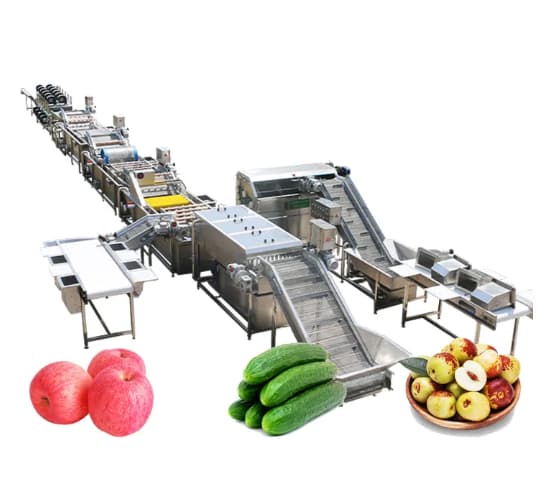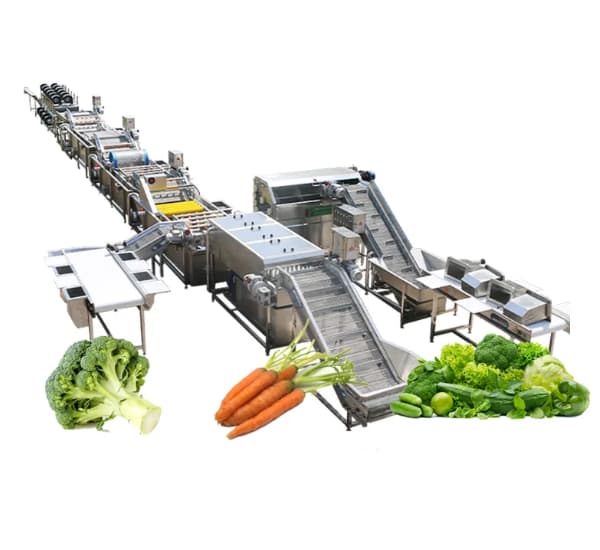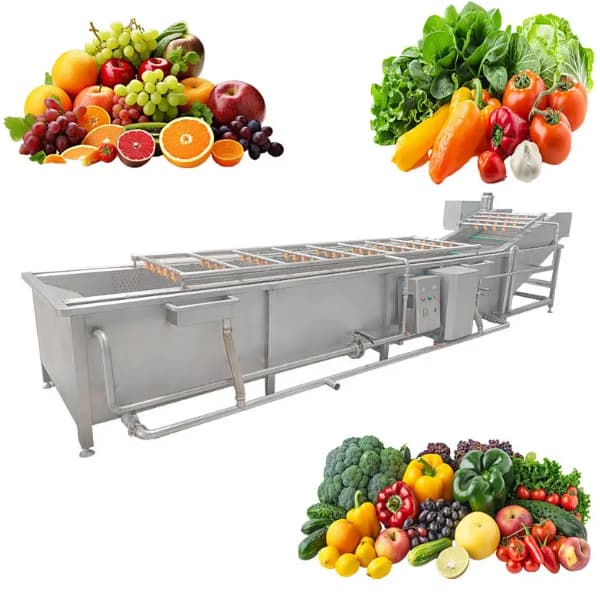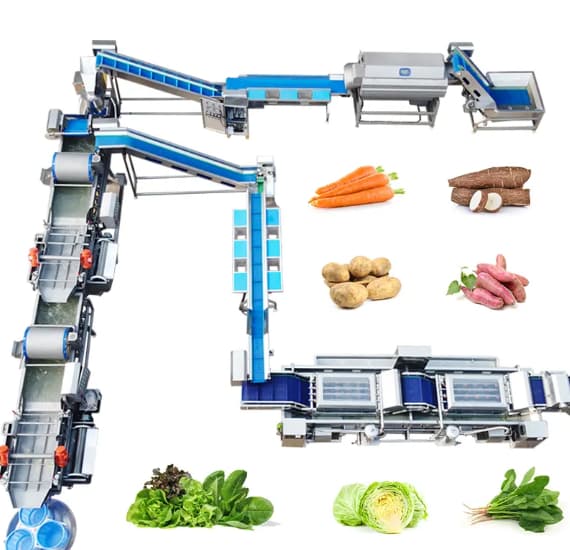Introduction
The industrial processing of fruits and vegetables is a fundamental pillar in the modern food chain. Thanks to innovation in machinery and automated lines, Today it is possible to transform fresh products into food ready for consumption, juices, frozen, Dehydrated or high quality can.
This article offers a detailed guide on the Fruit and vegetable processing at an industrial level, Analyzing the types of machinery, applications, Technical characteristics and the main benefits for companies in the agri -food sector.

1. Importance of industrial fruits and vegetable processing
1.1 Why process fruits and vegetables industrially?
The processing allows:
- Prolong the life of products.
- Guarantee food safety and hygiene.
- Improve production efficiency.
- Create products ready for consumption (4ª gama).
- Satisfy the global demand for healthy and convenient foods.
1.2 Current trends in fruit and vegetable processing
- Growth of natural juice consumption.
- Increased demand for frozen fruits (IQF).
- Healthy Snacks Market Expansion as dehydrated fruits.
- Salads ready to eat with minimal processing.
2. Main types of machinery for fruit and vegetable processing
2.1 Washing and disinfection of fruits and vegetables
| Machine | Model | Ability | Power | Features | Material |
|---|---|---|---|---|---|
| Bubble washing machine | DT-LB500 | 500 kg/h | 1.5 kW | Immersion and bubbling | Stainless steel 304 |
| Drum washing machine | DT-RT1000 | 1000 kg/h | 2.2 kW | Continuous rotary washing | Stainless steel 304 |
These machines eliminate land, PETICIDS AND ORGANIC WASTE, essential step to ensure the quality of the final product.
2.2 Fruit and vegetable peel machines
- Mechanical Pappera, Carrots, beet.
- Steam peppers for tomatoes and peaches.
- Citrus and mango pneumatic peppers.
2.3 Industrial cutters and slicing
| Machine | Model | Types of cut | Ability | Power |
|---|---|---|---|---|
| Multiple cutter | DT-CM200 | Juliana, cubes, slices | 200–500 kg/h | 0.75–1.5 kW |
| Precision slicer | DT-SL800 | Uniform slices | 800 kg/h | 1.1 kW |
The accuracy of the cut influences the presentation and subsequent processing of the product (as dehydrated or cooking).
2.4 Juice and pulp extraction
- Hydraulic and centrifugal presses for juices.
- Pulp extractors for tropical fruits (mango, guava, papaya).
- Integrated filtering and pasteurization systems.
2.5 Fruit and vegetable dehydrators
| Machine | Model | Ability | Heat source | Temperature |
|---|---|---|---|---|
| Tray dryer | DT-SB1000 | 1000 kg/lot | Electric / gas | 40–80°C |
| Continuous tunnel dryer | DT-TT2000 | 2000 kg/h | Gas natural | Automatic control |
Ideal for the production of dry banana, sliced apple, granulated carrot or fruit chips.
2.6 IQF Systems (Individual rapid freezing)
IQF tunnels allow you to individually freeze fruits and vegetables such as strawberries, blueberries, peas, broccoli, preserving color, TEXTURE AND NUTRITIONAL VALUE.

3. INDUSTRIAL AND VEGETABLE INDUSTRIAL PROCESSING APPLICATIONS
3.1 Production of natural juices and nectars
- Citrus processing, Tropical fruits, Grapes and apples.
- Low temperature pasteurization to keep flavor and nutrients.
- Pack in PET bottles, Aseptic glass or bag.
3.2 Frozen fruits manufacturing
- Strawberries, mangos, piña, blue, among others.
- Cut, washing, IQF and packaging in vacuum sealed bags.
3.3 Dehydrated fruits and vegetable production
- Banana chips, apple, kiwi.
- Dry tomato, onion in scales, grated carrot.
- Dried by trays or tunnel, With hot or infrared air systems.
3.4 Canned vegetables and fruits in syrup
- Canned tomato.
- Peach and pear in halves.
- Asparagus and mushrooms in jars.
4. DESIGN OF COMPLETE Fruit and vegetable processing lines
4.1 Basic configuration of an industrial line
- Reception and weighing
- Initial washing and classification
- Peeled and cut
- Cooking / disinfection (and apply)
- Extraction or processing (juices, Purés, etc.)
- Cooling or drying
- Packaging and labeling
- Storage or distribution
4.2 Smart Automation and Control
Modern lines include:
- PLCs (programmable logical controllers)
- HMI touch screens
- Temperature Sensors, humidity, weight
- Traceability systems and production registration

5. Advantages of automated processing
| Advantage | Description |
|---|---|
| Efficiency | Process large volumes in less time |
| Uniform quality | Reduction of human error |
| Hygiene | Lower product manipulation |
| Profitability | Labor cost reduction |
| Scalability | Adapts to production growth |
6. Key considerations when choosing fruit and vegetable machinery
6.1 Factors to take into account
- Type of fruit or vegetable to process
- Required production capacity
- Space available in plant
- Health regulations of the country
- Availability of spare parts
- Technical Support and Training
6.2 Recommended certifications
- CE (European Union)
- ISO 9001 (quality)
- HACCP (Food security)
- FDA (For export to the US. His.)
7. Example Technical Card: Fresh vegetable processing line
| Component | Model | Ability | Total power | Function |
|---|---|---|---|---|
| Bubble washing machine | DT-LB500 | 500 kg/h | 1.5 kW | Initial washing |
| Vegetable cutter | DT-CM300 | 300 kg/h | 0.75 kW | Julian cut |
| Centrifuge | DT-CF200 | 200 kg/h | 1.1 kW | Leaf drying |
| Vacuum packaging | DT-VP100 | 10 Cycles/min | 2.5 kW | Hermetic packaging |
8. Market projections and sustainability
8.1 Sector growth
According to FAO and Euromonitor data:
- The global fruit and vegetable processing market will grow a 6.2% annual up to 2029.
- Latin America and Asia lead expansion by exports and urban growth.
8.2 Sustainability and energy efficiency
- Equipment with Heat recovery y Water savings systems.
- Solar drying tunnels for tropical climates.
- High energy efficiency engines.
Conclusion
He industrial processing of fruits and vegetables It is a constantly evolving field. From automatic washing machines to freezing tunnels, Technology allows to transform fresh food into products with high added value, Ready for the demanding international markets.
Choose the right machinery, With well -defined technical parameters and reliable support, Marks the difference in efficiency, quality and profitability of a processing plant.
For companies that seek to climb their fruit and vegetable production in 2025, Investing in automated lines is more than an option: It is a strategic need.

